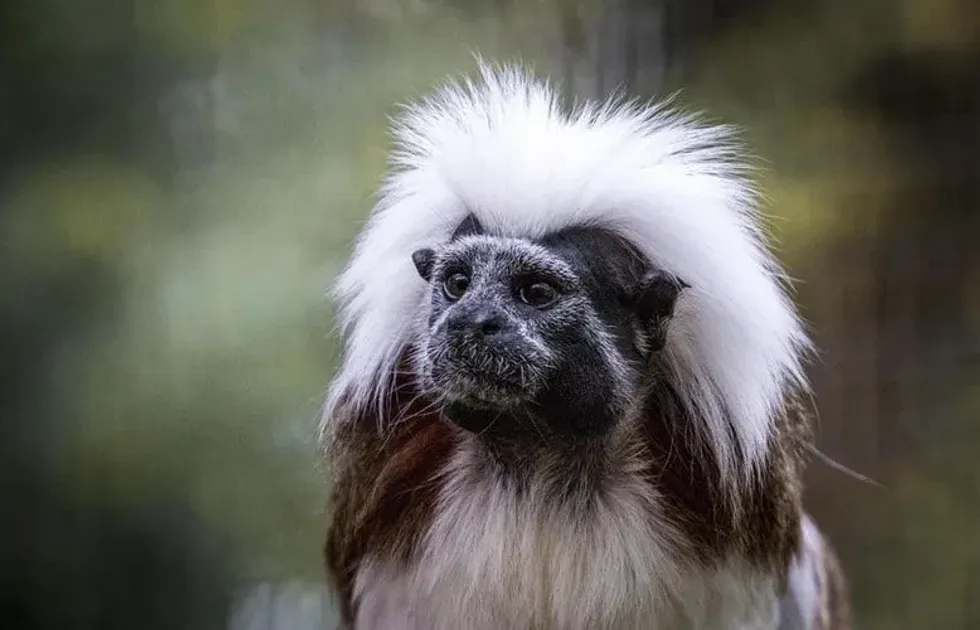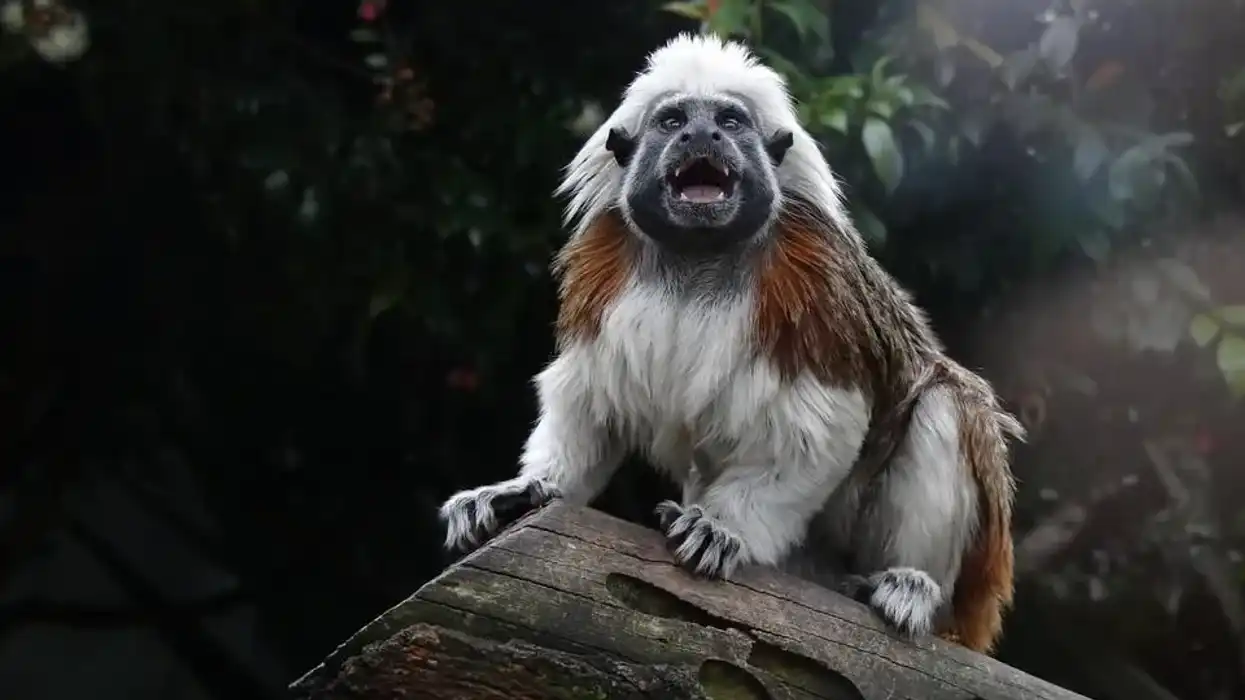Cotton-top tamarin (scientific name Saguinus oedipus), also known as cotton-headed tamarin, are the native primates of north-western Colombia and are found in various regions of South America. Cotton-top tamarins are both found in dry and humid tropical forests and, by personality, they are the clever and uniquely colored primates.
They can climb very quickly, are very cooperative and also maintain social structures intelligently. Their use of the level of intelligence and complicated vocalization makes them a very smart species.
Cotton-top tamarins play a major role of a seed disperser in the ecology.
They pursue an ability of eating and digesting large seeds which also removes dangerous parasites from their digestive canal. On the basis of facial features, we can easily classify cotton-top tamarins into three types: mottled, covered with fur, and bare-faced.
Let’s take a dive and know all the interesting facts about cotton-top tamarin. After reading all the cotton top tamarin cool facts, you may also look at pygmy slow loris facts and squirrel monkeys facts.
Cotton-Top Tamarin Interesting Facts
What type of animal is a cotton-top tamarin?
Cotton-top tamarin is a small new world monkey with scientific name Saguinus oedipus. They are named after the white hair that surrounds their heads giving a look which is very similar to that of Albert Einstein.
What class of animal does a cotton-top tamarin belong to?
Cotton-top tamarins belong to the class of mammals. The cotton-top tamarin give birth to their young ones and raise them with utmost care and feed them. Altogether, all these characteristics make them fall under the category of mammals.
How many cotton-top tamarins are there in the world?
Cotton-top tamarins are critically endangered and, currently, there are only around 400 in the wild. Between the 1960s and 1970s, the demand for significant quantities of these creatures arose in the United States.
As a result, huge quantities of these monkeys were sent to the US for different types of medical research.
Now that import of the cotton-top tamarins has been banned in the US there are still reports of cotton-top tamarins being used for medical research. As a matter of fact, the number of captive species is much higher than those in the wilderness.
Where does a cotton-top tamarin live?
They live in both dry and humid tropical forests. The population of cotton-top tamarins are now mainly found in the forested area of north-western Colombia.
What is a cotton-top Tamarin's habitat?
The cotton-top tamarin monkeys are native to a forested area which is small in size of north-western Colombia and are distributed in the geographic range from the Atrato River to the Magdalena river. They dwell in a canopy’s middle layer to gather fruits and other items such as insects that make up the most part of their diet.
Cotton-top tamarins are one of the three Amazonian species of tamarin.
Who do cotton-top tamarins live with?
Cotton-top tamarins live in their groups. Just like their distant relatives, the golden lion, these tamarins also create social family groups that look after the breeding process, the migrated adults who are not even related, and the related offspring. For protecting each other from large predators they work together in groups.
How long does a cotton-top tamarin live?
Cotton-top tamarins live for over 24 years under captivity, while its lifespan in the wild is around 13 years. The tamarins build their homes in huge trees where it also carry out all its daily activities including hunting and sleeping. The choice of their homes depends on the level of availability of food in that particular area.
How do they reproduce?
The cotton-top tamarins observe both monogamous and polygamous breeding. In every group, there is only one female tamarin who is engaged in the reproduction process.
This dominant female tamarin used here chemical behavior to establish supremacy over other females who are a part of the group.
Even though during the age of fifteen to eighteen months, the female tamarins become sexually mature, there are no signs that indicate that they are going through a regular ovarian cycle. When this ovarian cycle is going on, the mating process can occur during the entire duration.
Since nursing and caring for the young requires significant parental care, as a result, the females typically give birth during the early half of the rainy season when fruits are most abundant and they can have enough food to replenish their energy levels..
After the gestation period is over, the females give birth to twins. As a matter of fact, female tamarins are most likely to give birth to twins every year.
The weight of cotton-top tamarin's newly born one is one-fifth of the body weight of the mother, the adult tamarins help parents tamarins in carrying out their responsibilities towards the young members.
What is their conservation status?
This species of tamarins have been listed as ‘Critically Endangered’ under IUCN Red List. They featured on the list of species that are endangered and require conservation.
There are estimates that out of the original habitat of the tamarins, hardly five percent is remaining. As a result of this rapid reduction in their habitat, the expectations of these creatures conservation in the coming years have also been reduced.
Cotton-Top Tamarin Fun facts
What do cotton-top tamarins look like?
When it comes to the appearance of top tamarin primates, there are various interesting features that one can notice. First of all, they have a unique color and then there are white hairs circling around their face (which is of gray or silver color).
Their chest, legs and belly are usually of white color while their tail has a combination of black and brown shades. These primates have nails that are claw shaped that helps in moving from one tree to another in their habitat in the forest.
How cute are they?
The cotton-top tamarins are cute in their appearance as a result of the unique blend of white and black colors in their body skin.
How do they communicate?
Their main source of communication are chemical and vocal signs. As they dwell in dense forest regions, visual communication becomes difficult, if they are not in a closer contact with other group members. According to research, there are 38 distinct vocalizations from the cotton-top tamarin.
How big is a cotton-top tamarin?
Cotton-top tamarins are 8-10 in (head and body), 13-16 in (tail). They weigh around 0.08-0.10 lb. They are roughly the size of a squirrel.
How fast can a cotton-top tamarin run?
Cotton-top tamarin can run an average of 24 mph. They have excellent jumping abilities which helps them in leaping around 10 ft in air from one tree to another in the forest.
In catering to their requirement for altruism and cooperation, they create a complex social structure. Sacrifices are understood as a significant way of leading a life in the group, and the failure of any member to cooperate could invite retribution and punishment.
How much does a cotton-top tamarin weigh?
Male and female cotton top tamarins weigh less than a pound. Though, it varies according to their dietary habits and environment. The general weight range is around 0.08-0.10 lb.
What are their male and female names of the species?
There are no separate names for both genders. They are addressed simply as male and female.
According to researchers, tamarin mothers try to suppress their daughter’s fertility and for the rest of adult females present in the group. As the mother dies in the group, the oldest and most high-ranking daughter becomes fertile and carries out the dominant role of the mother.
What would you call a baby cotton-top Tamarin?
There are no specific names for the offspring of this tamarin species. They are referred to as infants or newborns.
What do they eat?
Being omnivores the cotton-top tamarin Saguinus oedipus eat both plants and animals available in the forest. They feed upon fruits, nectar, rodents, and insects.
Their diet comprises fruits and insects which they are able to find along the middle layer of the forest canopy. Some other reptiles are also consumed as a part of their diet.
Are they loud?
Their voice is high-pitched to the human ears. They are high-vocal animals.
It is evident that though their method of communication is not as evolved as that of humans, there are certain grammar-based rules that are reflected in their vocalizations. These vocalizations help in communication of intentions and emotions of the species.
For instance, studies show that this species can add syllables to words and can easily change the meanings. This finding has also revealed that there has been an evolution of the grammatical rules according to the understanding of the words.
Would they make a good pet?
Though, they are active, intelligent, and very social animals. They are not easy to pet. A cotton-top tamarin requires much more care and requirements than any other pet.
Moreover, it is illegal to pet a cotton-top tamarin as their species are critically endangered.
Did you know...
The scientific name for the cotton-top tamarin, “oedipus” means “swollen foot”. However, the tamarins don't have any large feet. The name was given by Carl Linnaeus simply because he liked the Greek tragedy “Oedipus Rex”.
How Cotton-Top Tamarins Have Adapted To Their Habitat
When they feel any threat, the cotton-top tamarins make efforts to appear bigger they engage in raising and lowering the white fan which is present on top of their heads.
A regular day in the life of a cotton-top tamarin consists of foraging food, resting, grooming, and travelling. During night, group members sleep in a different tree with a sufficient amount of covering to avoid predators.
The most common list of predators of these tamarins are birds of prey, snakes, jaguars and other wild cats. Since their habitat is a canopy, it shields them from such dangers. The survival need and instinct is not merely for one individual tamarin but for the whole group.
Are Cotton-Top Tamarins Critically Endangered?
Yes, the Cotton Top Tamarins are facing the threat of extinction as their conservation status has been categorized as ‘critically endangered’ due to illegal pet trade and habitat loss.
There has been an upsurge in their exploitation in northwestern Colombia by means of hunting and pet trade so much so that these Tamarins have become endangered species.
Recently, for carrying out a scientific research, as many as 40,000 of these cotton-top tamarins were captured and sent to foreign lands. Deforestation has posed one of the biggest habitat threats in front of the species.
It has led to the loss of their habitat (tropical forest), and forced them to live on the edges of the forest.
As a result of the high rate of development and modernization in agriculture, northwestern Colombia has witnessed an alarming rate of loss of the tropical rainforest; in fact, Colombia has become the seat for the fourth highest loss of the world’s rainforest.
Some of these losses can be attributed to the increased extraction of oil and also hydroelectric dam construction in northwestern Colombia which flooded around 7000 hectares of green area in the Paramillo National Park, which is a known sanctuary for these creatures.
Here at Kidadl, we have carefully created lots of interesting family-friendly animal facts for everyone to discover! Learn more about some other mammals including mangabey, or new world monkeys.
You can even occupy yourself at home by drawing one on our Cotton Top Tamarin coloring pages.









